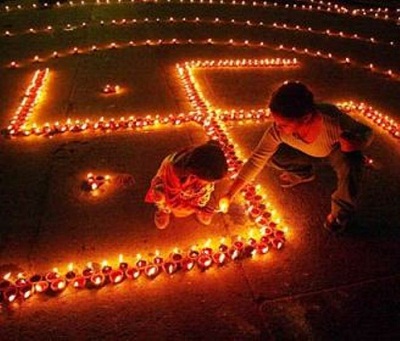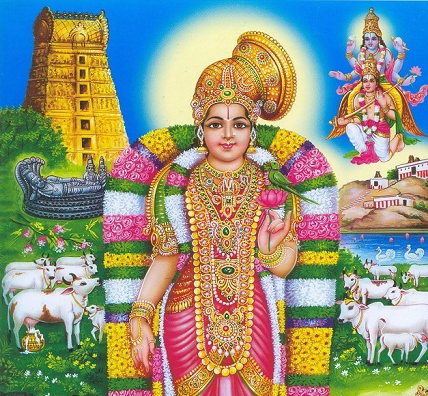What is Diwali?
Several myths, stories and legends that surround this bright festival. The common highlight of this dazzling festival is its enjoyment, happiness and goodness that it brings along with it. Diwali or Deepawali falls on the 13th Lunar day of the Hindu calendar in the month of Karthik (October – November).
Although Diwali is a pan-Indian festival, the celebrations, rituals and festivities differ from region to region. Know more about Diwali celebrations across India.
Celebrations in North India
People celebrate the victory of Lord Rama and return from his exile of 14 years with his wife Sita and Lakshmana. People lit lamps all along the way to welcome the Lord. This is celebrated on the Amavasya, the dark night, and following day marks the beginning of the Regional New Year (North India).
The festival is celebrated for five days starting with Dhanteras, Naraka Chaturdashi, Amavasya, Kartika Shuddha Padyami and Yama Dvitiya.
Dhanteras – First Day
The first day or trayodashi is also called Dhanteras. The name Dhanteras comes from Dhan, meaning wealth and Tera, the 13th lunar day of the Krishn Paksh. Since Goddess Lakshmi symbolises wealth, people worship her on this day.
They make beautiful Rangoli on the pathways of their homes welcoming the Goddess. People worship by singing Lakshmi Aartis or mantras evoking the Goddess. It is a belief that buying gold or silver jewelry on this day will double the wealth. Hence, people make a beeline to the jewelry shops to buy gold and silver.
It is also beleieved that Lord Dhanawantari, the god of health, came out of the ocean with Ayurveda and blessed the mankind. Dhanteras marks the start of Deepawali/Diwali celebrations.
There is a legend where a wife saves her husband from the jaws of death of Yama on this day. At sunset on this day, people take bath and offer diyas (Yamdeep daan or Yama Deepam) and sweets to Yama Raj, the Lord of Death and pray to protect their family against untimely death. People usually make this offering near the Holy Basi or Tulsi tree.
Choti Diwali – Second Day
This is the second day or Naraka Chaturdashi, before the main Diwali celebrations. It is celebrated on a smaller scale with fewer lights and firecrackers. The rituals and traditions are different on this day in the South.
Lakshmi Puja – Third Day
The third day is considered to be the important day in the north as they celebrate the Lakshmi Puja on this day. People celebrate this day with a lot of energy and enthusiasm. Houses are cleaned as it is believed that the Goddess likes those houses that are clean.
Lamps are lit in the evening to welcome the goddess. The main Puja comprises in worshipping of Ganesh, Mahalakshmi, Mahasaraswati, Mahakali and Kuber. Evening is cheerful when people gather to wish, greet, share sweets, exchange gifts, burst firecrackers and have a grand feast together.
Govardhan Puja/Gudi Padwa – Fourth Day
The third day is known as Bali Padyami and marks the beginning of the rule of King Bali in Bhoolok as per Lord Vishnu’s boon. In some parts of North India, this day is observed as Gudi Padwa, which celebrates the love between husband and the wife.
People of Punjab, Haryana, UttarPradesh and Bihar perform the Govardhan pooja on this day to commemorate the lifting of the Mount Govardhan by Krishna.
Bhai Duj – Fifth Day
Two days after Diwali is celebrated as Bhai Dhuj, a day dedicated for sisters. It is believed that on this day, Yamraj, the lord of death visited his sister, Yamuna after a long period of separation. Pleased by her reception, Yama gave a boon to his sister that if a sister puts a tilak on the brother’s forehead, no harm shall befall him. Thus, sisters pray for the welfare of their brothers on this day.
The day is marked with sharing of gifts and spending time together, thus strengthening the bond between brothers and sisters.
This day marks the end of Diwali celebrations.
Celebrations in South India
In the South, this festival is celebrated mainly on Naraka Chaturdashi and commemorates the end of evil demon – Narakasura by Krishna during the Dwapara Yuga. It signifies the victory of good over evil.
This festival is observed in the month of ‘Aipasi’. People decorate their homes and prepare for the Diwali Pooja. Celebrations start a day before when things are kept ready for the oil bath the following day. New dresses and crackers are kept along with other ingredients in the pooja room.
Hindus wake up early in the morning and have oil bath. The elders in the family bless family members and give them the new dresses and gifts. It is believed that taking bath before sunrise on this day is equivalent to taking a dip in the Holy Ganges. They draw decorative and elaborate Kolams.
People offer pooja to Vishnu or Krishna, who was instrumental in eliminating the evil. After the pooja, the family indulges in sweets and other special dishes for the occasion. Medicinal mix or the Lehyam is given to all the family members to keep indigestion in check due to over-eating.
Rows of lamps are lit in the evenings outside the homes. People exchange greetings, wishes and distribute sweets. Young people revel in the celebrations by bursting firecrackers.






